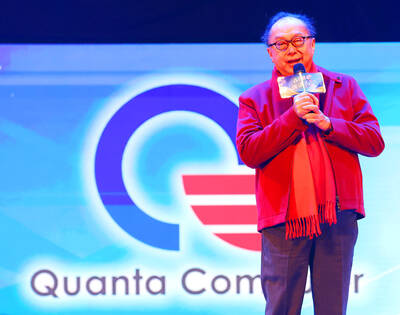Eyeing the opportunities that closer economic cooperation with China represents, investors are favoring financial and property stocks, while losing their appetite for shares of tech companies, which are struggling amid the slump in demand.
But Wistron Corp (緯創) defied the trend last quarter, becoming one of the tech stars on the local bourse. The nation’s No. 3 contract maker of notebooks outshone its rivals, expanding revenues nearly 40 percent year-on-year in the quarter ending June 30.
Wistron shares gained 49 percent in the second quarter to NT$54.5 from NT$36.55 at the end of March, beating the TAIEX index’s 23 percent gain.
The local bourse has outperformed its Asian counterparts in recent quarters.
“Wistron is our preferred notebook original design manufacturer [ODM], given its solid execution, strong growth prospects, improving cash conversion cycle and focus on profitability,” Ellen Tseng (曾雅蘭), an analyst with Nomura’s Taipei branch, said in a report on June 23.
Wistron’s notebook shipments may expand 16 percent this year to 25.5 million units, Tseng predicted.
She gave a “buy” rating for Wistron, compared with a “neutral” rating on bigger rivals Quanta Computer Inc (廣達) and Compal Electronics Inc (仁寶).
Tseng is one of many tech analysts who have made Wistron their favorite stock among PC companies trading shares in Taiwan.
Foreign investors have significantly increased their holding in Wistron to 64.92 percent at the beginning of this month from 46.18 percent at the beginning of the year.
But Wistron’s story has not always been positive. For a long time, the company struggled after spinning off from Acer Inc (宏碁) in 2001. In recent years, it has gained ground by expanding its customer line-up to include Dell Inc, Hewlett-Packard Co and Lenovo Group Inc (聯想).
Commenting on the transformation, Wistron chairman Simon Lin (林憲銘) said innovation was an important factor to increasing a company’s value.
At a June 11 seminar on strategies to ride out the financial crisis, Lin said: “Economic slowdown has prompted some crucial changes in the PC industry’s value chain. Big PC brands are tightening their research and development budgets and even cutting marketing spending. These changes represent new opportunities for ODMs to increase their value.”
To find growth opportunities in a time of economic recession, Lin suggested manufacturers form innovation teams to brainstorm product ideas for customers rather than simply seeking to offer lower production costs — an almost impossible mission that squeezes profits.
Rather than the conventional approach of leaving new products to engineers, Wistron’s innovation teams are in themselves innovative. They consist mostly of employees with expertise outside of engineering and include a higher percentage of women, Lin told the forum, organized by CommonWealth magazine.
In addition, Wistron is forming deeper partnerships with customers by helping them provide cheaper and faster maintenance and logistics services to PC users, Lin said.
The company helps clients provide these services in Taiwan, Hong Kong, China, Japan, Singapore and North America, he said.
In other words, Wistron is more than a traditional ODM, he said: It offers technological services.
In addition to rethinking its business model, Wistron has improved its technological capabilities. The company focuses on research and development (R&D) to make sure it can offer products that meet the needs of customers and end-users.
In the first quarter, the company spent NT$1.74 billion on R&D, up roughly 25 percent from a year earlier, a financial statement showed.
At the end of last year, Wistron had 4,000 R&D employees in Taipei and Shanghai.
Wistron’s innovation efforts have paid off, helping it differentiate itself from rivals with similar products, analysts said.
“We expect Wistron’s innovations to lead to expanding margins and contribute to bottom line growth in the next few years. We think Wistron’s customers could be willing to pay a premium for these proprietary technologies, allowing the company’s margins to improve in the near term or maintain [their current level],” UBS AG analyst Edward Yen (顏子傑) said in a report last week.
Wistron’s operating margin may expand to 2 percent next year from an estimated 1.8 percent this year, Yen said.
In addition, new designs and orders are expected to fuel sales growth during the second half of the year, and the momentum may carry into next year, Taipei-based KGI Securities (凱基證券) said.
Wistron may ship a new notebook model with real-time 2D-to-3D conversion for Acer in the third quarter, KGI analyst Angela Hsiang (向子慧) said in a report late last month.
Currently, users must wear shutter glasses for 3D images when playing games on PCs.
After acquiring a 17 percent stake in Dynamic Digital Depth several years ago, Wistron has exclusive access to the software technology for the next five years, Hsiang said.
The acquisition allowed Wistron to become the first company to apply the 3D solution to laptops.
Demand for devices enabling real-time 2D-to-3D conversion may grow faster after the technology is extended to TVs in the coming years, she said.
In additional to potential 25 percent growth in its core notebook business on new orders from HP and Lenovo, the company will see growth from LCD TVs, new all-in-one PCs and handsets this year and next year, she said.
LCD TV shipments may nearly double to between 4.5 million and 5 million units next year, Hsiang said.
In the handset market, Wistron is expected to make a breakthrough by shipping mobile phones to a US customer next year, with an estimated volume of between 3 million and 5 million units, KGI said.
Though the underlying growth potential makes Wistron an attractive investment target, investors are advised to wait for a proper entry point as the stock has more than doubled so far this year.
UBS’ Yen suggested investors who aim for long-term returns buy Wistron shares in the third quarter, as the stock price may drop on weaker-than-expected back-to-school PC demand.
Yen raised the target price for Wistron to NT$64 from NT$55 for the next 12 months, joining in a wave of overseas brokerages to revalue the company upward.

Quanta Computer Inc (廣達) chairman Barry Lam (林百里) is expected to share his views about the artificial intelligence (AI) industry’s prospects during his speech at the company’s 37th anniversary ceremony, as AI servers have become a new growth engine for the equipment manufacturing service provider. Lam’s speech is much anticipated, as Quanta has risen as one of the world’s major AI server suppliers. The company reported a 30 percent year-on-year growth in consolidated revenue to NT$1.41 trillion (US$43.35 billion) last year, thanks to fast-growing demand for servers, especially those with AI capabilities. The company told investors in November last year that

Intel Corp has named Tasha Chuang (莊蓓瑜) to lead Intel Taiwan in a bid to reinforce relations between the company and its Taiwanese partners. The appointment of Chuang as general manager for Intel Taiwan takes effect on Thursday, the firm said in a statement yesterday. Chuang is to lead her team in Taiwan to pursue product development and sales growth in an effort to reinforce the company’s ties with its partners and clients, Intel said. Chuang was previously in charge of managing Intel’s ties with leading Taiwanese PC brand Asustek Computer Inc (華碩), which included helping Asustek strengthen its global businesses, the company

Taiwanese suppliers to Taiwan Semiconductor Manufacturing Co. (TSMC, 台積電) are expected to follow the contract chipmaker’s step to invest in the US, but their relocation may be seven to eight years away, Minister of Economic Affairs J.W. Kuo (郭智輝) said yesterday. When asked by opposition Chinese Nationalist Party (KMT) Legislator Niu Hsu-ting (牛煦庭) in the legislature about growing concerns that TSMC’s huge investments in the US will prompt its suppliers to follow suit, Kuo said based on the chipmaker’s current limited production volume, it is unlikely to lead its supply chain to go there for now. “Unless TSMC completes its planned six

Power supply and electronic components maker Delta Electronics Inc (台達電) yesterday said it plans to ship its new 1 megawatt charging systems for electric trucks and buses in the first half of next year at the earliest. The new charging piles, which deliver up to 1 megawatt of charging power, are designed for heavy-duty electric vehicles, and support a maximum current of 1,500 amperes and output of 1,250 volts, Delta said in a news release. “If everything goes smoothly, we could begin shipping those new charging systems as early as in the first half of next year,” a company official said. The new